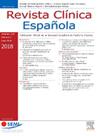Retraso diagnóstico y oportunidades perdidas en la detección precoz de la fibrilación auricular: estudio transversal
IF 1.7
4区 医学
Q2 MEDICINE, GENERAL & INTERNAL
引用次数: 0
Abstract
Introduction
We analysed the frequency of atrial fibrillation (AF) delayed diagnosis and the factors associated with it in newly diagnosed patients.
Methods
This was a descriptive, cross-sectional, multicentre study. Data were collected from newly diagnosed patients with AF through medical records review and interviews during cardiology, internal medicine, primary care and emergency department consultations in Spain.
Results
A total of 201 physicians participated in the study (64.2% cardiologists, 21.4% internists). 948 patients (58% men; mean age 72.8 years) were included. In 41.8% of patients, AF was classified as paroxysmal at diagnosis, 30.9% as persistent and 27.3% as permanent. The diagnosis was coincidental in 37%. It was considered that a delayed diagnosis occurred in 49.3% of patients. This delay was associated with the presence of permanent or persistent AF, older age or valvular disease. 74.8% of patients had some contact with the healthcare system in the preceding year. The diagnosis could have been established between 1-6 months earlier in 50.7% of cases and more than six months earlier in 20.1%. 54.4% of the patients had experienced AF compatible symptomatology previously. Of these, 32.6% had a consultation without a diagnosis.
Conclusions
In a significant proportion of AF cases, there is a diagnostic delay. Many people with compatible symptoms neither seek consultations nor contact the healthcare system facilities. Consequently, the opportunity for early diagnosis is lost.
心房颤动早期检测中的延迟诊断和错失良机:一项横断面研究
引言 我们分析了新诊断患者中房颤(AF)延迟诊断的频率及其相关因素。方法 这是一项描述性、横断面、多中心研究。通过病历审查和在西班牙心脏病科、内科、初级保健科和急诊科就诊时进行的访谈,收集了新诊断的房颤患者的数据。结果 共有 201 名医生参与了研究(64.2% 为心脏病专家,21.4% 为内科医生)。共纳入 948 名患者(58% 为男性;平均年龄 72.8 岁)。41.8%的患者在诊断时被归类为阵发性房颤,30.9%的患者被归类为持续性房颤,27.3%的患者被归类为永久性房颤。37%的患者的诊断是巧合。49.3%的患者被认为是诊断延迟。这种延迟与存在永久性或持续性房颤、年龄较大或瓣膜疾病有关。74.8%的患者在前一年与医疗系统有过一些接触。50.7%的病例可在 1-6 个月前确诊,20.1%的病例可在 6 个月前确诊。54.4%的患者之前出现过与房颤相似的症状。结论 在很大一部分心房颤动病例中,诊断存在延误。许多有类似症状的人既不就诊,也不与医疗系统设施联系。因此,丧失了早期诊断的机会。
本文章由计算机程序翻译,如有差异,请以英文原文为准。
求助全文
约1分钟内获得全文
求助全文
来源期刊

Revista clinica espanola
医学-医学:内科
CiteScore
4.40
自引率
6.90%
发文量
73
审稿时长
28 days
期刊介绍:
Revista Clínica Española published its first issue in 1940 and is the body of expression of the Spanish Society of Internal Medicine (SEMI).
The journal fully endorses the goals of updating knowledge and facilitating the acquisition of key developments in internal medicine applied to clinical practice. Revista Clínica Española is subject to a thorough double blind review of the received articles written in Spanish or English. Nine issues are published each year, including mostly originals, reviews and consensus documents.
 求助内容:
求助内容: 应助结果提醒方式:
应助结果提醒方式:


